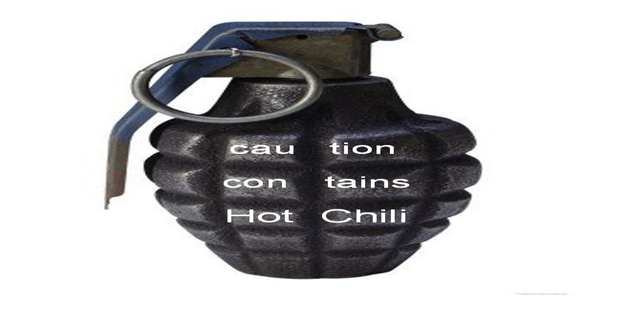Pepper-Chilli Grenades: India's "Hot New Weapon" to Be Tried Out on Kashmiris

NEW DELHI: It is now official. The Union Home Ministry expert committee has recommended he use of “PAVA shells”, in other words chili based “less-lethal” munition that incapacitates the targets and renders them immobile. And this according to the experts is better than pellet guns that will of course remain in use as what they claim will be a secondary option.
Indigenously developed this “latest hot new weapon” as described by sections of the foreign media, was made public in 2010. And this is what The Sun and Fox News had to say about what is now being touted by the expert committee as a “less lethal” weapon for crowd control.
“At more than a thousand times stronger than the average cooking spice the bhut jolokia chili is set to cause a potent explosion on more than just the taste buds.Military experts in India have developed the new crowd control grenade packed with ground seeds from the chili -- which is officially recognized as the hottest on the planet by Guinness World Records.When deployed the grenade showers the targets with a dust so spicy that in trials subjects were blinded for hours and left with breathing problems.
Lead scientist R.B. Srivastava, from India's Defense Research and Development Organisation, said: "The chilli grenade is a non-toxic weapon and when used would force a terrorist to come out of his hideout.The effect is so pungent that it would literally choke them." The hotness of the bhut jolokia, which is native to Assam, in north-east India, is measured in Scoville heat units and comes in at a massive 1,001,304 -- that is nearly twice as hot as Mexico's red savina that used to hold the record at 577,000.”
The committee now has claimed that PAVA is different from “chilli grenades” as these are “bio safe (whatever that means in a human condition) better than chilli grenade or tear smoke shell and can also be used in combination with stun and tear shells.” These remain far more lethal than pepper gas that is recognised as having often a deadly impact and the use of which in Kashmir in 2013 led to deaths that were raised by senior lawmakers at the time.
Former Director General Border Security Force EN Rammohan who was posted in Jammu and Kashmir during the troubled times of 1993 regretted the use of such weapons on protesters. He insisted that there could be no replacement to a lathi charge, along with water cannons and tear gas shells when required. He said that pellet guns were lethal, and had not been used in any state except Kashmir where these were brought in in 2010 by the CrPF. Rammohan said it was inhuman to use these pellet cartridges against civilians, as these could kill, and usually blinded victims.
The widespread criticism of the use of these guns on Kashmiri protesters leading not just to casualties but crippling injuries including blindings, led the government to set up an expert committee to suggest a replacement. During his visit to Srinagar Union Home Minister Rajnath Singh said that the committee was beating the two month deadline by almost a month, and its findings would be made public soon. Apart from laser and acoustic measures, the main weapon for crowd control in Kashmir suggested now are these chilli-pepper grenades which burst, and release the toxic substance that blinds and chokes the crowd. The blinding is supposed to be temporary, but there is evidence that the release of the substance packed into the grenade causes severe respiratory problems that can result in death.
Given the fact that the pellet guns became more lethal as they were fired straight, at close range into the crowds instead of a mandatory distance, it is safe to presume that the grenades launched straight into protesting mobs would have a more rather than a less lethal impact. Interestingly these grenades have not been tried on a large scale basis before, with several military officers not certain of the level of impact. Kashmir thus will become the laboratory for the grenades that can also be used, as per earlier media reports, to still wild elephants.



